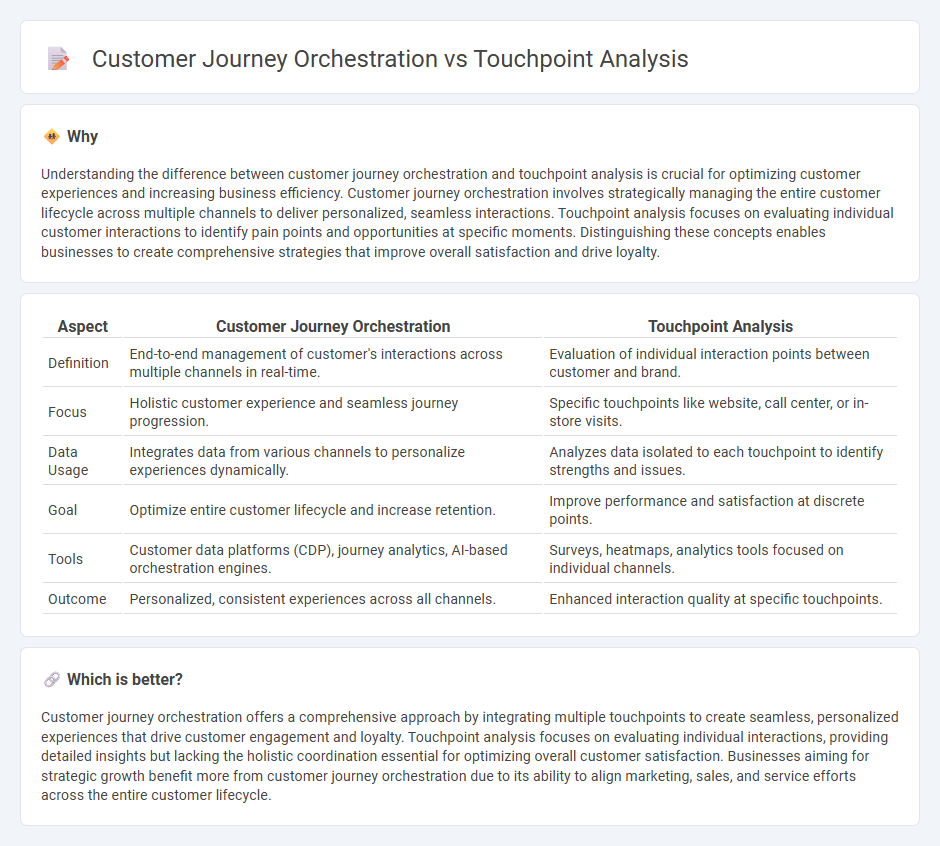
Customer journey orchestration integrates data across channels to deliver personalized, seamless experiences, driving higher engagement and loyalty. Touchpoint analysis focuses on evaluating individual interactions to identify pain points and optimize specific customer contacts. Explore how combining both approaches can transform your customer experience strategy.
Why it is important
Understanding the difference between customer journey orchestration and touchpoint analysis is crucial for optimizing customer experiences and increasing business efficiency. Customer journey orchestration involves strategically managing the entire customer lifecycle across multiple channels to deliver personalized, seamless interactions. Touchpoint analysis focuses on evaluating individual customer interactions to identify pain points and opportunities at specific moments. Distinguishing these concepts enables businesses to create comprehensive strategies that improve overall satisfaction and drive loyalty.
Comparison Table
| Aspect | Customer Journey Orchestration | Touchpoint Analysis |
|---|---|---|
| Definition | End-to-end management of customer's interactions across multiple channels in real-time. | Evaluation of individual interaction points between customer and brand. |
| Focus | Holistic customer experience and seamless journey progression. | Specific touchpoints like website, call center, or in-store visits. |
| Data Usage | Integrates data from various channels to personalize experiences dynamically. | Analyzes data isolated to each touchpoint to identify strengths and issues. |
| Goal | Optimize entire customer lifecycle and increase retention. | Improve performance and satisfaction at discrete points. |
| Tools | Customer data platforms (CDP), journey analytics, AI-based orchestration engines. | Surveys, heatmaps, analytics tools focused on individual channels. |
| Outcome | Personalized, consistent experiences across all channels. | Enhanced interaction quality at specific touchpoints. |
Which is better?
Customer journey orchestration offers a comprehensive approach by integrating multiple touchpoints to create seamless, personalized experiences that drive customer engagement and loyalty. Touchpoint analysis focuses on evaluating individual interactions, providing detailed insights but lacking the holistic coordination essential for optimizing overall customer satisfaction. Businesses aiming for strategic growth benefit more from customer journey orchestration due to its ability to align marketing, sales, and service efforts across the entire customer lifecycle.
Connection
Customer journey orchestration relies on touchpoint analysis to map and optimize each interaction a customer has with a brand, ensuring seamless experiences across channels. By analyzing touchpoints, businesses can identify pain points and opportunities for improvement, driving personalized engagement and increased customer satisfaction. This connection enables consulting firms to design strategic interventions that enhance overall journey effectiveness and boost conversion rates.
Key Terms
**Touchpoint Analysis:**
Touchpoint analysis identifies and evaluates each interaction between customers and a brand to improve customer experience and optimize marketing strategies. It provides detailed insights into customer behavior at specific points such as websites, social media, or customer service calls, enabling targeted improvements. Explore how touchpoint analysis can transform your customer engagement and boost satisfaction.
Interaction Mapping
Touchpoint analysis involves identifying and evaluating each customer interaction point to optimize customer experience and increase engagement efficiency. Customer journey orchestration extends beyond mapping by actively managing and personalizing interactions across multiple channels in real-time for seamless experiences. Explore how integrating interaction mapping enhances strategic orchestration for deeper customer insights and improved satisfaction.
Pain Point Identification
Touchpoint analysis concentrates on identifying specific pain points by examining individual interactions between customers and the brand, providing granular insights into moments of friction. Customer journey orchestration leverages these insights to dynamically align and optimize multiple touchpoints, creating a seamless experience that proactively addresses pain points throughout the entire customer lifecycle. Discover how integrating touchpoint analysis with journey orchestration enhances pain point resolution and drives customer satisfaction.
Source and External Links
Customer touchpoints: How to identify them + examples - Zendesk - Touchpoint analysis involves mapping the customer journey to identify every interaction point where customers engage with a brand, helping to optimize and create a seamless experience by addressing pain points at each touchpoint.
Customer Touchpoint Analysis | Customerly - Customer Touchpoint Analysis evaluates all interaction points between a business and its customers, using data and mapping to improve customer satisfaction, loyalty, and business profitability.
Touchpoint Analysis: How Can You Improve Customer Contact? - Zenloop - Touchpoint analysis examines all customer-brand contacts, both direct and indirect, across channels like websites, social media, ads, and phone support to optimize customer experience and marketing effectiveness.
 dowidth.com
dowidth.com